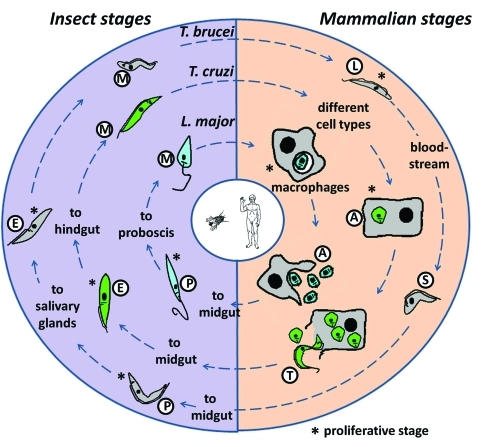Figure 1.
The Tri-Tryp life cycles. Representation of the life cycles of Leishmania major, Trypanosoma cruzi and T. brucei, the etiological agents of leishmaniasis, Chagas disease and sleeping sickness, respectively, are shown, with the parasitic forms that are present in the insect vectors and the mammalian hosts. Leishmania major proliferates as promastigotes (P) in the sand fly midgut. The parasite is transmitted during bites by this fly and invades mammalian macrophages in the metacyclic promastigote (M) form. Inside the cell, the M form is converted into amastigotes (A) and divides before been released during cell lysis. Trypanosoma cruzi replicates as epimastigotes (E) in the reduviid bug midgut and develops into infective metacyclic trypomastigotes that are excreted in the feces (M) and invade different cell types when in contact with the mammalian host. After differentiation into proliferative amastigotes (A), these are transformed into bloodstream trypomastigotes (T) that cause cell lysis and invade new cells. Trypanosoma brucei differentiates from procyclic (P) to epimastigote (E) proliferative forms in the tsetse fly before being transformed into infective, metacyclic forms (M) in the salivary glands. After being injected into the host during a blood meal, M forms differentiate into long slender forms (L) that proliferate in the bloodstream and can reach the central nervous system. After increase of parasite numbers these last forms are replaced by non-proliferative stumpy forms (S).

